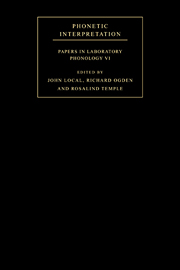Book contents
- Frontmatter
- Contents
- List of contributors
- Acknowledgements
- Introduction
- Part I Phonological representations and the lexicon
- Part II Phonetic interpretation and phrasal structure
- 6 Release the captive coda: the foot as a domain of phonetic interpretation
- 7 How many levels of phrasing? Evidence from two varieties of Italian
- 8 Domain-initial articulatory strengthening in four languages
- 9 External sandhi as gestural overlap? Counter-evidence from Sardinian
- 10 Commentary: Consonant strengthening and lengthening in various languages
- Part III Phonetic interpretation and syllable structure
- Part IV Phonology and natural speech production: tasks, contrasts and explanations
- References
- Index of names
- Index of subjects
6 - Release the captive coda: the foot as a domain of phonetic interpretation
Published online by Cambridge University Press: 22 September 2009
- Frontmatter
- Contents
- List of contributors
- Acknowledgements
- Introduction
- Part I Phonological representations and the lexicon
- Part II Phonetic interpretation and phrasal structure
- 6 Release the captive coda: the foot as a domain of phonetic interpretation
- 7 How many levels of phrasing? Evidence from two varieties of Italian
- 8 Domain-initial articulatory strengthening in four languages
- 9 External sandhi as gestural overlap? Counter-evidence from Sardinian
- 10 Commentary: Consonant strengthening and lengthening in various languages
- Part III Phonetic interpretation and syllable structure
- Part IV Phonology and natural speech production: tasks, contrasts and explanations
- References
- Index of names
- Index of subjects
Summary
Introduction
An important general goal in furthering our understanding of the phonetics–phonology interface is to determine precisely the manner in which prosodic conditions influence the phonetic interpretation of segmental information. The specific goal of this paper is to demonstrate how the set of conditioning contexts can be advantageously constrained by abandoning ambisyllabicity – the device whereby a consonantal position is granted dual membership of neighbouring syllables. The phonetic interpretation of supposedly ambisyllabic consonants can be straightforwardly detailed by reference to their location within the independently necessary domain of the foot.
The paper starts in Section 6.2 by questioning some of the fundamental assumptions that ambisyllabic analyses typically make about the nature of the phonetics–phonology interface. Section 6.3 presents specific arguments for rejecting the device in favour of a foot-centred approach. Section 6.4 introduces a range of facts involving manner and source contrasts in Danish which would submit to a standard ambisyllabic analysis but which can be quite adequately characterised in terms of the foot. Section 6.5 outlines a theory of segmental form which allows explicit statements to be made about how foot-sensitive effects map onto the acoustic signal. Section 6.6 extends the analysis to Ibibio. Section 6.7 presents the main conclusions.
A minimalist take on the phonetics–phonology interface
One widely appealed-to justification for ambisyllabicity is that it defines a conditioning site for allophonic realisation.
- Type
- Chapter
- Information
- Phonetic InterpretationPapers in Laboratory Phonology VI, pp. 103 - 129Publisher: Cambridge University PressPrint publication year: 2004



